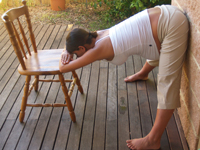
Pregnancy is the perfect time to indulge in some all important self-love. Whether it’s soaking in the tub, getting a massage, or practising restorative yoga, you’ll not only revive your energy and spirits, but you can also feel good about the fact that your baby-in-utero will be reaping the benefits!
These days it’s fairly well known that stress may adversely affect the development of a foetus. It’s not surprising then that many doctors and midwives routinely recommend yoga to their antenatal patients.
Pregnancy can be a time when feelings of anxiety may arise as you prepare for a new, unknown direction in your life. Yoga, especially restorative yoga, helps to support and strengthen your nervous system and that of your developing baby’s. Regular yoga practice induces the ‘relaxation response’ which counter-acts your ‘fight or flight’ or ‘stress response’, promoting feelings of wellbeing and making you more resistant to the negative effects of stress.
1. Supported Prasarita Padottanasana with chair and wall
Setting up: Have your feet out a few inches from the wall, sit-bones resting on the wall. Keep the sit-bones pressed up and into the wall as you bend forward from the hips to place your hands and then your forearms onto the seat of chair in front. Fold the arms and rest the forehead onto one forearm. If necessary, place a higher support on the chair such as a folded blanket or bolster to make sure you can rest in the pose with ease, without rounding the spine.
The spine should be long and shoulders relaxed. Keep pressing the buttock bones into the wall, which tends to enhance the lengthening effects on the spine and hamstrings in this pose. Stay here for up to 5 minutes.
Benefits: This is a cooling posture, as the head is supported on the forearms and the heart is lower than the rest of the body, providing the benefits of slight inversion. Also, because the legs are wide apart it helps to open the hips and pelvis, stretching the pelvic floor. It can also help alleviate aches and pains in the lower back.
2. Supported Supta Virasana with inclined bolster
Lower yourself slowly along the bolster, tucking your buttocks under to lengthen your lower back as you do. Let your arms rest to the side, palms upper-most and relax and soften back into the support. Have the knees together or slightly apart. Breathe deeply here for up to 10 minutes.
Benefits: This is a wonderful digestive pose, which may ease the discomfort of heartburn and abdominal over-crowding during pregnancy, helping create a feeling of more space in the torso for both mum and bub. It also lengthens the muscles of the quadriceps (front of the thighs) and hip flexors, releasing tightness in the lower back caused by increasing lumbar lordosis (arching of the lower back). The chest-opening effects of this pose also facilitate deeper breathing, calming the mind and the nerves.
Ana Davis specialises in yoga for women’s health and conducts prenatal and postnatal teacher training workshops at Byron Yoga Centre. Read more about her upcoming workshop. Look out for her latest articles on yoga and pregnancy and birth in the August and October issues of Wellbeing Magazine.